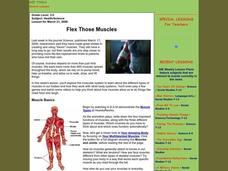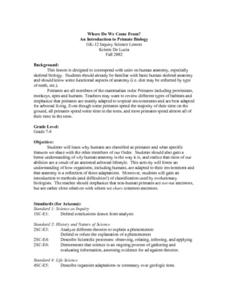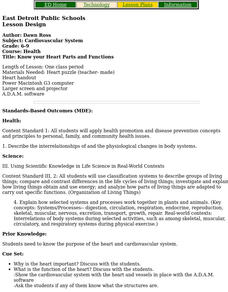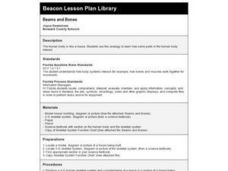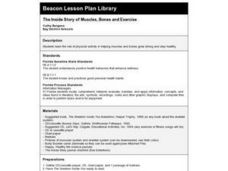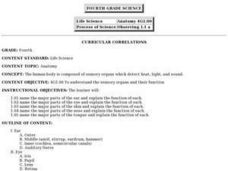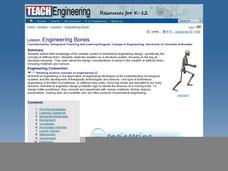Curated OER
Take Two and Call Me in the Morning
Eighth graders are introduced to the workings of the major systems of the Human Body: circulatory, digestive, respiratory, nervous, skeletal, and endocrine Systems. They learn the major organs of the systems and their functions.
Curated OER
Flex Those Muscles
Students explore the muscular system to examine the different types of muscles in our bodies and how they work with other body systems. They discover how muscles help us chew food and laugh. Videos are used as part of this instructional...
Curated OER
From Human Skeletons to Owl Pellets to Paleontology
Learners explore about the function of the skeleton and comprehend the names of the bones of the human skeleton. They compare bones of the human skeleton to a dinosaur skeleton and graph to compare these bones. Students sort bones to...
National First Ladies' Library
Rosie the Riveter
Learners identify and interpret the power of symbols. Then they research and identify what type of information that they can locate at the Library of Congress website and list what they learned from it in the time allotted. Students also...
Curated OER
Ecology Lessons
Students examine the relationship between animal adaptations, habitats and community interactions. In this ecology instructional activity students complete a skull detective worksheet then use their knowledge to analyze a skull.
Curated OER
Where Do We Come From? An Introduction to Primate Biology
Seventh graders explore skeletal biology. Through a discussion and video observation, 7th graders investigate how the anatomy is adapted to the environment. Students study primates and explore their characteristics and behaviors.
Curated OER
Know your Heart Parts and Functions
Students put together a 3-D interactive "heart" puzzle and learn the names of heart parts.
Curated OER
Comparing Fossils
Students explore early hominid evolution as they analyze bones that share characteristics of both apes and humans. Students compare and contrast key skeletal differences between chimpanzees and humans. In groups, they sort and group a...
Curated OER
Human Traces
Students create and construct human skeletons by rubbing casts of bone impressions on paper, and then label most important components of human skeleton.
Curated OER
Animal skeletal design-reduction relief prints
Sixth graders compare and contrast various forms of artistic expression associated with specific groups of people, geographic regions, or time periods, specifically, art of Australia, and create art works using procedures borrowed from...
Curated OER
The effects of microgravity
Fourth graders are given a scenario in the instructional activity that presents a problem that needs to be solved. They conduct research from multiple sources in order to gather information. This is used to contribute to possible...
Curated OER
Anatomy
Fourth graders describe how health behaviors affect body systems, and describe the basic function of major body systems.
Curated OER
Deep Sea Coral Biodiversity
Students research life forms of both tropical coral reefs and deep-sea coral reefs to discover the biodiversity of the ecosystems. They compare and contrast the diversity and adaptations of the two eco-systems, and draw a picture showing...
Curated OER
Three Dimensional Art of Vertebrates and Invertebrates
Learners, during this twelve week series of lessons, learn basic anatomy through life sketches of human skeletons and shells. They learn fundamentals of line and convey life through sketches learning science through art.
Curated OER
The Human Body Lesson
Students identify features of the human body, explore needs of the human body by explaining the importance of good health in relationship to the body, and study functions and care of the human body and its organs.
Curated OER
MuscleMania
Students learn three different types of muscles. By building a model of the arm, they learn its basic anatomy and how muscles function in relationship to bones. They perform an experiment on the relationship between muscle size and...
Curated OER
Skeleton
Students study the skeleton. In this human body lesson, students draw and label bones in the body by tracing each other and creating a skeleton out of body parts and brass fastners.
Curated OER
Beams and Bones
Fifth graders learn how parts of the human body interact and how bones and muscles work together.
Curated OER
The Inside Story of Muscles, Bones and Exercise
First graders explore how they can help their muscles and bones grow strong through the use of physical activity.
Curated OER
Anatomy
Fifth graders identify and describe the functions of the major body systems. They discover how to maintain a healthy lifestyle with proper nutrition and exercise. They answer comprehension questions to end the lesson.
Curated OER
Movement, it's FUN-damental!
High schoolers discover how muscles work. For this biology lesson, students explain the causes of fatigue and muscle soreness. They create graphs and compare results with their classmate.
Curated OER
Make a Dinosaur
Students estimate the size of dinosaurs and create a dinosaur model. They create bar graphs of the sizes of dinosaurs one in meters and the other in "student" units. They draw a pictures and add words or sentences about their dinosaur.
Baylor College
Gravity and Muscles
Humans are so used to gravity as a force that we don't tend to pay much attention to it on a daily basis. Through a couple simple activities, learners experience changes to their center of gravity and come to the understanding that...
Curated OER
Engineering Bones
Students identify the features of a prosthetic limb and explain how engineers are involved in the prosthetic design. In this bone engineering lesson students describe the design criteria that goes into choosing the materials that go...



